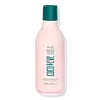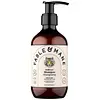What's inside
What's inside
 Key Ingredients
Key Ingredients

No key ingredients
 Benefits
Benefits

 Concerns
Concerns

 Ingredients Side-by-side
Ingredients Side-by-side

Water
Skin ConditioningSodium C14-16 Olefin Sulfonate
CleansingSodium Methyl Cocoyl Taurate
CleansingCetyl Betaine
CleansingSodium Cocoamphoacetate
CleansingLauryl Glucoside
CleansingGlycerin
HumectantCocos Nucifera Oil
MaskingAnanas Sativus Fruit Extract
Skin ConditioningNephelium Lappaceum Branch/Fruit/Leaf Extract
Skin ConditioningHydrolyzed Hyaluronic Acid
HumectantArgania Spinosa Kernel Oil
EmollientFicus Carica Fruit Extract
HumectantPersea Gratissima Oil
Skin ConditioningHydrolyzed Pea Protein
EmollientSapindus Trifoliatus Fruit Extract
Skin ConditioningSodium Hyaluronate
HumectantCocos Nucifera Fruit Juice
EmollientCocos Nucifera Water
MaskingPsidium Guajava Fruit Extract
AstringentPhospholipids
Skin ConditioningGlycol Distearate
EmollientPolyquaternium-22
Sodium Cocoyl Glutamate
CleansingSodium Lauryl Glucose Carboxylate
CleansingSodium Stearoyl Lactylate
EmulsifyingGlyceryl Caprylate
EmollientGlyceryl Stearate
EmollientPropanediol
SolventCetearyl Alcohol
EmollientTetrasodium Glutamate Diacetate
Glyceryl Undecylenate
EmollientPolyglyceryl-10 Dioleate
EmulsifyingPolyglyceryl-10 Oleate
Skin ConditioningGuar Hydroxypropyltrimonium Chloride
Skin ConditioningCocamidopropyl Betaine
CleansingLaureth-4
EmulsifyingAcrylates/C10-30 Alkyl Acrylate Crosspolymer
Emulsion StabilisingSodium Benzoate
MaskingPotassium Sorbate
PreservativeParfum
MaskingBenzyl Salicylate
PerfumingCoumarin
PerfumingLinalool
PerfumingCitric Acid
BufferingWater, Sodium C14-16 Olefin Sulfonate, Sodium Methyl Cocoyl Taurate, Cetyl Betaine, Sodium Cocoamphoacetate, Lauryl Glucoside, Glycerin, Cocos Nucifera Oil, Ananas Sativus Fruit Extract, Nephelium Lappaceum Branch/Fruit/Leaf Extract, Hydrolyzed Hyaluronic Acid, Argania Spinosa Kernel Oil, Ficus Carica Fruit Extract, Persea Gratissima Oil, Hydrolyzed Pea Protein, Sapindus Trifoliatus Fruit Extract, Sodium Hyaluronate, Cocos Nucifera Fruit Juice, Cocos Nucifera Water, Psidium Guajava Fruit Extract, Phospholipids, Glycol Distearate, Polyquaternium-22, Sodium Cocoyl Glutamate, Sodium Lauryl Glucose Carboxylate, Sodium Stearoyl Lactylate, Glyceryl Caprylate, Glyceryl Stearate, Propanediol, Cetearyl Alcohol, Tetrasodium Glutamate Diacetate, Glyceryl Undecylenate, Polyglyceryl-10 Dioleate, Polyglyceryl-10 Oleate, Guar Hydroxypropyltrimonium Chloride, Cocamidopropyl Betaine, Laureth-4, Acrylates/C10-30 Alkyl Acrylate Crosspolymer, Sodium Benzoate, Potassium Sorbate, Parfum, Benzyl Salicylate, Coumarin, Linalool, Citric Acid
Water
Skin ConditioningSodium Cocoyl Isethionate
CleansingAloe Barbadensis Leaf Juice
Skin ConditioningCocamidopropyl Hydroxysultaine
CleansingParfum
MaskingDecyl Glucoside
CleansingLauryl Glucoside
CleansingSodium Lauroyl Sarcosinate
CleansingMaltitol
HumectantXylitol
HumectantXylitylglucoside
HumectantAnhydroxylitol
HumectantCocos Nucifera Oil
MaskingHelianthus Annuus Seed Oil
EmollientPueraria Lobata Root Extract
HumectantBacopa Monnieri Extract
Skin ConditioningEclipta Prostrata Extract
Skin ConditioningPelvetia Canaliculata Extract
Skin ProtectingAegle Marmelos Root Extract
Skin ConditioningCentella Asiatica Extract
CleansingDesmodium Gangeticum Root Extract
Skin ConditioningGmelina Arborea Root Extract
Skin ConditioningOroxylum Indicum Root Extract
Skin ConditioningPremna Serratifolia Root Extract
Skin ConditioningSolanum Indicum Root Extract
Skin ConditioningSolanum Xanthocarpum Root Extract
MaskingStereospermum Suaveolens Root Extract
Skin ConditioningTribulus Terrestris Root Extract
Skin ConditioningOrbignya Speciosa Kernel Oil
EmollientCurcuma Longa Root Extract
MaskingMelia Azadirachta Leaf Extract
Skin ConditioningPhyllanthus Emblica Fruit Extract
HumectantWithania Somnifera Root Extract
Skin ConditioningAstrocaryum Murumuru Seed Butter
EmollientLinum Usitatissimum Seed Oil
PerfumingHibiscus Sabdariffa Flower Extract
Skin ConditioningTrigonella Foenum-Graecum Seed Extract
PerfumingHydroxypropyl Guar Hydroxypropyltrimonium Chloride
Hydrolyzed Wheat Protein Pg-Propyl Silanetriol
Skin ConditioningEthylhexylglycerin
Skin ConditioningPolyquaternium-10
Polyquaternium-7
Glycerin
HumectantCoconut Acid
CleansingSodium Isethionate
CleansingSodium Lauroyl Lactylate
EmulsifyingCoco-Glucoside
CleansingDisodium Cocoyl Glutamate
CleansingGlyceryl Oleate
EmollientCitric Acid
BufferingPotassium Sorbate
PreservativePhenoxyethanol
PreservativeLeuconostoc/Radish Root Ferment Filtrate
AntimicrobialCoumarin
PerfumingWater, Sodium Cocoyl Isethionate, Aloe Barbadensis Leaf Juice, Cocamidopropyl Hydroxysultaine, Parfum, Decyl Glucoside, Lauryl Glucoside, Sodium Lauroyl Sarcosinate, Maltitol, Xylitol, Xylitylglucoside, Anhydroxylitol, Cocos Nucifera Oil, Helianthus Annuus Seed Oil, Pueraria Lobata Root Extract, Bacopa Monnieri Extract, Eclipta Prostrata Extract, Pelvetia Canaliculata Extract, Aegle Marmelos Root Extract, Centella Asiatica Extract, Desmodium Gangeticum Root Extract, Gmelina Arborea Root Extract, Oroxylum Indicum Root Extract, Premna Serratifolia Root Extract, Solanum Indicum Root Extract, Solanum Xanthocarpum Root Extract, Stereospermum Suaveolens Root Extract, Tribulus Terrestris Root Extract, Orbignya Speciosa Kernel Oil, Curcuma Longa Root Extract, Melia Azadirachta Leaf Extract, Phyllanthus Emblica Fruit Extract, Withania Somnifera Root Extract, Astrocaryum Murumuru Seed Butter, Linum Usitatissimum Seed Oil, Hibiscus Sabdariffa Flower Extract, Trigonella Foenum-Graecum Seed Extract, Hydroxypropyl Guar Hydroxypropyltrimonium Chloride, Hydrolyzed Wheat Protein Pg-Propyl Silanetriol, Ethylhexylglycerin, Polyquaternium-10, Polyquaternium-7, Glycerin, Coconut Acid, Sodium Isethionate, Sodium Lauroyl Lactylate, Coco-Glucoside, Disodium Cocoyl Glutamate, Glyceryl Oleate, Citric Acid, Potassium Sorbate, Phenoxyethanol, Leuconostoc/Radish Root Ferment Filtrate, Coumarin
 Reviews
Reviews

Ingredients Explained
These ingredients are found in both products.
Ingredients higher up in an ingredient list are typically present in a larger amount.
Citric Acid is an alpha hydroxy acid (AHA) naturally found in citrus fruits like oranges, lemons, and limes.
Like other AHAs, citric acid can exfoliate skin by breaking down the bonds that hold dead skin cells together. This helps reveal smoother and brighter skin underneath.
However, this exfoliating effect only happens at high concentrations (20%) which can be hard to find in cosmetic products.
Due to this, citric acid is usually included in small amounts as a pH adjuster. This helps keep products slightly more acidic and compatible with skin's natural pH.
In skincare formulas, citric acid can:
While it can provide some skin benefits, research shows lactic acid and glycolic acid are generally more effective and less irritating exfoliants.
Most citric acid used in skincare today is made by fermenting sugars (usually from molasses). This synthetic version is identical to the natural citrus form but easier to stabilize and use in formulations.
Read more about some other popular AHA's here:
Learn more about Citric AcidCocos Nucifera Oil is obtained from the kernels of the coconut fruit. In other words, this is coconut oil.
Coconut Oil is rich in fatty acids with lauric acid making up the majority of these. It also contains linoleic acid. Due to this high fatty acid content, coconut oil helps trap moisture and soften skin.
Despite being antibacterial, coconut oil may not be great for acne-prone skin. It is comedogenic and may clog pores. This ingredient may not be safe for malassezia or fungal acne.
Note: Coconut Oil should not replace your sunscreen for UV protection. Studies show it only blocks about 20% of UV.
This oil is non-volatile and has a light scent.
The term 'fragrance' is not regulated in many countries. In many cases, it is up to the brand to define this term. For instance, many brands choose to label themselves as "fragrance-free" because they are not using synthetic fragrances. However, their products may still contain ingredients such as essential oils that are considered a fragrance.
Learn more about Cocos Nucifera OilCoumarins are a group of substances found naturally in plants. There are over 1300 types of coumarins identified. It has a natural vanilla scent.
Coumarin is an identified EU known allergy, meaning it may cause an allergic reaction when applied to the skin.
In many countries, coumarin is banned as a food additive. However, it can be found in soaps, tobacco products, and some alcohol drinks.
Plants use coumarins as a chemical defense. Some plants that have coumarins include lavender, tonka beans, and yellow clovers.
Learn more about CoumarinGlycerin is already naturally found in your skin. It helps moisturize and protect your skin.
A study from 2016 found glycerin to be more effective as a humectant than AHAs and hyaluronic acid.
As a humectant, it helps the skin stay hydrated by pulling moisture to your skin. The low molecular weight of glycerin allows it to pull moisture into the deeper layers of your skin.
Hydrated skin improves your skin barrier; Your skin barrier helps protect against irritants and bacteria.
Glycerin has also been found to have antimicrobial and antiviral properties. Due to these properties, glycerin is often used in wound and burn treatments.
In cosmetics, glycerin is usually derived from plants such as soybean or palm. However, it can also be sourced from animals, such as tallow or animal fat.
This ingredient is organic, colorless, odorless, and non-toxic.
Glycerin is the name for this ingredient in American English. British English uses Glycerol/Glycerine.
Learn more about GlycerinLauryl Glucoside sugar- and lipid-based cleansing agent. It is created from glucose and lauryl alcohol.
This ingredient is a surfactant, making it easier to rinse oil, dirt, and other pollutants away.
A British study found lauryl glucoside to cause skin sensitivity for some people. We recommend speaking with a professional if you have concerns.
Other names for this ingredient include "Lauryl Polyglucose", "Lauryl glycoside", and "D-Glucopyranoside".
Learn more about Lauryl GlucosideParfum is a catch-all term for an ingredient or more that is used to give a scent to products.
Also called "fragrance", this ingredient can be a blend of hundreds of chemicals or plant oils. This means every product with "fragrance" or "parfum" in the ingredients list is a different mixture.
For instance, Habanolide is a proprietary trade name for a specific aroma chemical. When used as a fragrance ingredient in cosmetics, most aroma chemicals fall under the broad labeling category of “FRAGRANCE” or “PARFUM” according to EU and US regulations.
The term 'parfum' or 'fragrance' is not regulated in many countries. In many cases, it is up to the brand to define this term.
For instance, many brands choose to label themselves as "fragrance-free" because they are not using synthetic fragrances. However, their products may still contain ingredients such as essential oils that are considered a fragrance by INCI standards.
One example is Calendula flower extract. Calendula is an essential oil that still imparts a scent or 'fragrance'.
Depending on the blend, the ingredients in the mixture can cause allergies and sensitivities on the skin. Some ingredients that are known EU allergens include linalool and citronellol.
Parfum can also be used to mask or cover an unpleasant scent.
The bottom line is: not all fragrances/parfum/ingredients are created equally. If you are worried about fragrances, we recommend taking a closer look at an ingredient. And of course, we always recommend speaking with a professional.
Learn more about ParfumPotassium Sorbate is a preservative used to prevent yeast and mold in products. It is commonly found in both cosmetic and food products.
This ingredient comes from potassium salt derived from sorbic acid. Sorbic acid is a natural antibiotic and effective against fungus.
Both potassium sorbate and sorbic acid can be found in baked goods, cheeses, dried meats, dried fruit, ice cream, pickles, wine, yogurt, and more.
You'll often find this ingredient used with other preservatives.
Learn more about Potassium SorbateWater. It's the most common cosmetic ingredient of all. You'll usually see it at the top of ingredient lists, meaning that it makes up the largest part of the product.
So why is it so popular? Water most often acts as a solvent - this means that it helps dissolve other ingredients into the formulation.
You'll also recognize water as that liquid we all need to stay alive. If you see this, drink a glass of water. Stay hydrated!
Learn more about Water